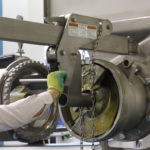Wisk, the Advanced Air Mobility (AAM) company backed by Boeing, has revealed a new design of its self-flying, all-electric, four-passenger vertical takeoff and landing (eVTOL) air taxi.
The Generation 6 vehicle, described as a “go-to-market aircraft”, is the first-ever candidate for type certification by the FAA of an autonomous eVTOL, Wisk said.
The advanced air taxi features autonomous technology but will be supervised by a ground control operator who will act in a role similar to an air traffic controller, the company said.
Wisk said safety was at the core of the new design, which has been simplified from previous iterations, and features skids in place of wheels. The aircraft has a price target of $3 per passenger, per mile.
“In 2010, we set out to find a way to skip traffic and get to our destination faster,” said Gary Gysin, CEO of Wisk.
“That inspiration evolved into a mission to deliver safe, everyday flight for everyone. Over the past 12 years, we’ve pursued that mission through the development of five different generations of full-scale aircraft. Our 6th Generation aircraft is the culmination of years of hard work from our industry-leading team, learnings from our previous generations of aircraft, commitment from our investors, and the evolution and advancement of technology.”
The new design of the aircraft by Wisk, one of the only AAM companies to pursue a self-flying first approach, includes a six-boom, 12-propeller design with improved propulsion systems. The cabin is larger than previous designs and caters for passengers will different levels of mobility.
Specifications and Performance
Cruising speed: 120 knots
Range: 90 miles with reserves (~144 kilometers with reserves)
Altitude: 2,500 – 4,000 ft above ground
Seats: 4
Dimensions: <50 foot wingspan
Power: electric
Operation: Autonomous with human oversight
Design and Configuration
Wisk’s 6th Generation aircraft design and configuration
Tilting propulsion units in front of the wing and fixed lift units aft of the wing are optimised for range, improved aircraft control and performance, and efficient energy management.
A raised wing design, extended booms, and increased size and number of propeller blades improves safety, stability, and the passenger experience, while reducing both in-cabin noise and the aircraft’s overall noise footprint.
The design features a larger passenger cabin with four seats and storage for baggage and personal carry-on items.
Wisk is primarily focused on FAA certification but is keeping EASA updated on the progress being made. “We want to be compliant with the EASA requirements as well,” said Sebastien Vigneron, SVP, Engineering & Programmes at Wisk.
Subscribe to the FINN weekly newsletter

